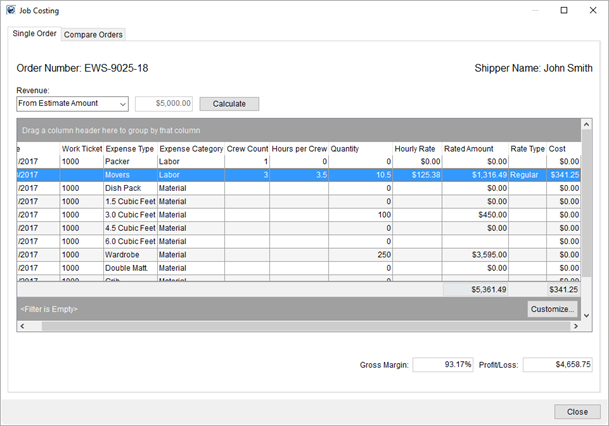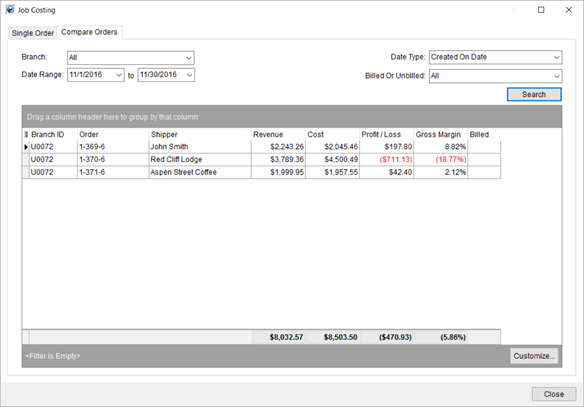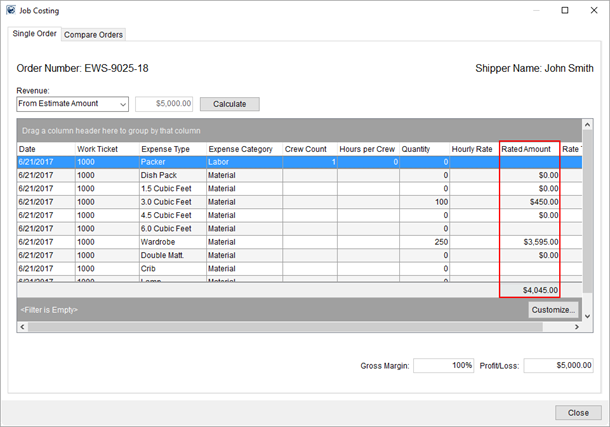
The Job Costing screen, available through the Tools Menu, allows you to calculate the anticipated cost of a local move request and compare it to potential revenue (billed, estimated, or quoted). This tool allows you to visualize the profitability of the move before dispatching services and before revenue is recorded.

Figure 1: Job Costing window
Job Costing allows you to view costing and rated costs for a Single Order (see Figure 1) or for multiple orders across a given date range through the Compare Orders tab (Figure 2).

Figure 2: Compare Orders tab
Costing data is grouped into the classifications of Equipment, Labor, Material, and Third Party.

Figure 3: Example illustrating grouping on Expense Category
The following table describes the general expense categories available through Job Costing.
|
Expense Category |
Description |
|
Equipment |
Resource assignments and requests through Local Dispatch and Local Services can be included in Job Costing. These resources tie to Equipment Type records where you can assign an average cost to an item by type and link the item to rating associated to the Rate Plan on the order. |
|
Labor |
General category of expenses for crew assignments through Local Dispatch and requests through Local Services. Costing data pulls from either crew records individually or from the labor type classification, depending on setup. Rating data is also available based on the Labor Type of the crew involved. A Cost Benefits Percentage can be applied to account for indirect costs related to the service or employee. |
|
Material |
Material items needed for the Local Services request can be included in Job Costing. Costing data is based on the item cost for each specified item. Additionally, rating can be applied to determine revenue associated to Containers, Packing, and Unpacking items. |
|
Third Party |
This is a general category for third party services set for the order through the Third Part Services option on the Billing Information tab (see Add Third Party Item). |
Gross Margin and Profit/Loss
MoversSuite takes costing data assigned to an order through containers, personnel, and other expenses and uses this information to calculate estimated gross margin and profit or loss on an order. Users, such as dispatchers, can use the Job Costing data to assist in assigning crew, equipment, and materials on Local Services in a manner that contributes to optimizing revenue.

Figure 4: Gross Margin and Profit Loss from Single Order tab
Personnel in charge of estimating and revenue can also access the Job Costing screen for an order to enhance their workflow targets.
NOTE: The Job Costing is a separate window from MoversSuite, therefore you can work concurrently in both MoversSuite while accessing the Job Costing data.
Rated Amount
In addition to the cost associated to expenses on a service and the estimated, rated, or quoted amount of revenue, you can also view the anticipated (or billed) revenue of items based on what is set within a Rate Plan. The Rated Amount column displays the amount calculated for an item. Additionally, the total of all rated items is available to compare to costing by choosing the From Rated Amount option within the Revenue source selector.

Figure 5: Rated Amount column within Single Orders tab
The Hourly Rate and Rate Type columns also provide information on the amounts that factor into the Rated Amount of an item.
View the Job Costing Rating topic for more information.
Using the Job Costing Screen
There are three phases of a costing for a local service order request. They include Planning Phase, Dispatch Phase, and an Actuals Phase. During each phase, you can calculate costings and potential revenue data during each of these phases. The following sections provide a framework to guide you in utilizing Job Costing information during each of these phases.
Planning Phase of Job Costing
During the initial phase of Job Costing, requests are generated through the Local Services tab based on initial estimates. In this phase, equipment, materials, and third party services may be documented on the order and visible within the Job Costing screen.
Affecting the cost of the order at this phase include the following:
•Labor Request associated to Local Services
•Equipment Request associated to Local Services
•Material costs that include Containers, Packing, and Unpacking entered through the Move Information tab and associated to Local Services
•Third Party Services set through the Billing Information tab
Expenses added to the order or included on each service automatically appear within the Single Order tab within the Job Costing screen. The date of service for an item determines what rates are in effect for Job Costing Rating.
The Estimate Amount can be set (Billing Information tab) to drive the initial revenue within Job Costing.
Once services are ready, a Quote can be generated and provided to the customer. Total charges for all quotes on the order with a status of Accepted can factor into revenue. Refer to the Source option within the Single Order tab.
NOTE: Services with a Service Date of “To be determined” do not show in Job Costing.
Dispatch Phase of Job Costing
Services are sent to dispatch and anticipated Equipment, Labor, and Materials assignments are made within Local Dispatch within the Dispatch Phase of Job Costing. The quantity and times associated to these assignments supersede those set during the Planning Phase.
Updated service dates and times determine what rates are in effect for Job Costing Rating.
Dispatchers can view the Single Order tab and determine the profitability of the initial estimates within the Job Costing screen. Assignment and other adjustments can be made and communicated to all personnel to make the move more profitable.
Actual Phase of Job Costing
In the Actual Phase of Job Costing, information regarding the service work performed is returned to the dispatcher and actuals are entered through the Enter Actuals screen, which may include any third-party services provided. Entries made in the Actual Phase supersede those of Dispatch Phase, except for the Rated Amount of Labor, which is based on the Dispatch Phase only.
Once actuals are entered for the order, the application only considers actuals for all categories. For example, if actuals are entered for Materials and not Labor, then only rated Materials factor into Job Costing totals; rated Labor is excluded until actuals are entered for them.
Actual dates and times can affect the rating information on the order.
Revenue is documented and the customer is invoiced.
Job Costing is considered final once the Bill Date is set on the order. Job Costing data cannot be updated once finalized.
Job Costing data is reviewed by all parties.
On an ongoing basis, you can utilize the Compare Orders tab to see the results of certain sets of orders (by branch).